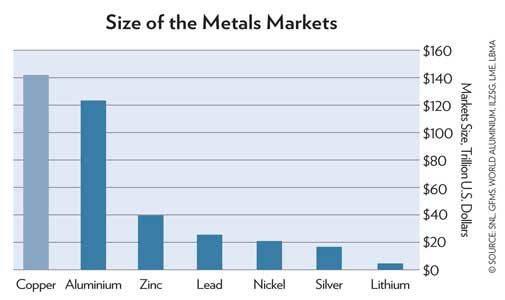Copper Prices Soaring to New Highs
David Forest, Caseyresearch.com
Governments around the world are rushing to secure copper supplies. Why? Just look at the chart.
The global copper market is bigger than the market for any other industrial metal. The value of copper bought and sold around the world is seven times that of other metals, like nickel…and about 30 times that of the global market for lithium.
Historically, much of that copper demand has been driven by infrastructure building. Copper is essential in making the wire used to transmit electricity. But the race for this key metal is about to get even more heated…because of the next wave of development in electricity infrastructure.
I’m talking about the widespread roll-out of electric vehicles (EVs).
A traditional internal combustion engine—an engine that generates power by burning gasoline, oil, or other fuel—uses 50 pounds of copper per vehicle. But hybrid electric vehicles require 88 pounds of copper per vehicle—74% more metal.
And that’s just the start. If we move to fully battery-powered vehicles, 182 pounds of copper will be needed to make one car. That’s a 260% increase in copper requirements.
When the supply crunch hits—which could be very soon—it’s going to cause a copper price spike that will lift all stocks in this sector.
Profit When the Markets Talk Turkey
Ted Baumann, Banyanhill.com
Even before its current crisis, the Turkish lira was among the world’s worst-performing currencies, dropping by half against the U.S. dollar in the past 12 months.
Turkey’s private and public sector debt is high, with $350 billion of it borrowed in U.S. dollars from foreign banks to take advantage of low interest rates. Inflation is over 15%, five times the average for the country’s peers.
But Turkey’s problems are about to become an opportunity for foreign investors. Here’s why.
As an important, mid-sized economy closely integrated with Europe and global trade, Turkey is full of foreign banks, including Spain’s BBVA, Italy’s UniCredit, and France’s BNP Paribas. If Turkish borrowers begin to default on their loans, these banks will suffer, just as they did when Greece, Italy, and other countries faced similar problems after the financial crisis of 2008.
And, as always, Turkey’s problems are having an immediate impact on other mid-sized economies. The Russian ruble, Australian dollar, South African rand, and the Mexican and Argentine pesos are falling fast, as investors looking for a safe haven flee to the dollar, Swiss franc, and Japanese yen.
The weakness of the South African rand versus the U.S. dollar means investors can buy more investments in South Africa more cheaply right now.
When the Turkish crisis abates—as it must eventually—these assets will rise in value in U.S. dollar terms. The same is true of assets in every country now suffering because of contagion from the Turkish crisis. That’s why crises in global “emerging markets” are actually investment opportunities.
Collectibles Defuse Market Volatility
Jocelynn Smith, Banyanhill.com
When it comes to looking for ways to ramp up the growth of your investment portfolio, we tend to first look to the stock market. You can even do it on your smartphone.
But it’s important to diversify your portfolio in such a way that it includes more than just stocks.
When, not if, the market crashes, the stocks in your portfolio will take a beating. Years could pass before they return to their pre-crash levels
It’s important to diversify your portfolio.
However, the value of collectibles isn’t directly correlated to the market. Stocks can plummet in value, but collectibles will make gains.
Not surprisingly, collectibles are mostly held in the hands of avid collectors and fans. They don’t sell their items just because the economy is weak or the stock market tanks. They hold on for years. This helps to keep prices steadily rising.
Collectibles can cover a wide swath of rare, tangible items for investment. Like, say, an iconic jacket worn by the star in a major motion picture. More common items include stamps, fine art, antiques, watches, cars, books, coins, and wine.
For instance, Liv-ex tracks the prices of a variety of fine wines and actually publishes a series of indices. Over the past year the Fine Wine Index 1000 has soared 9.9%, and it has increased 34.5% over the past five years. Not a bad return.
Collectibles offer another avenue for increasing your wealth, while shielding you from overall market volatility that can wipe out years of gains. Take steps today to explore this unique asset class.


